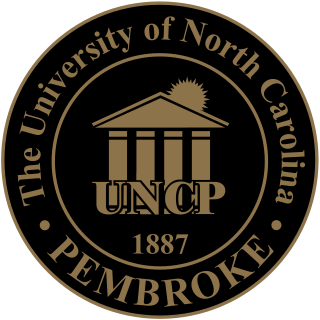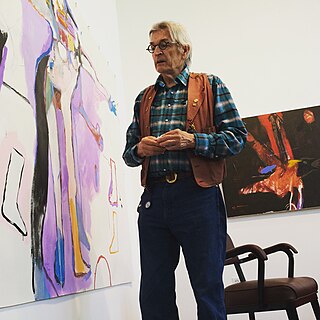
Robeson County is a county in the southern part of the U.S. state of North Carolina. As of the 2010 census, the population was 134,168. Its county seat is Lumberton. The county was formed in 1787 from part of Bladen County. It was named in honor of Col. Thomas Robeson of Tar Heel, a hero of the Revolutionary War.

Prospect is a census-designated place (CDP) in Robeson County, North Carolina. The population was 690 at the 2000 census. Located due northeast of Pembroke, North Carolina, Prospect is a traditionally Methodist community, with its church members largely becoming representatives for the entirety of the American Indian-Methodist community. Prospect is noted for one of its native sons, Adolph Dial, whose contributions to American Indian Studies have led to an heightened awareness of the local Lumbee Tribe and Native Americans throughout the Southeastern United States.

The University of North Carolina at Pembroke is a public university in Pembroke, North Carolina. UNC Pembroke is a master's level degree-granting university and part of the University of North Carolina system. Its history is intertwined with that of the Lumbee nation.

The Lumbee Tribe of North Carolina is a state-recognized tribe in North Carolina numbering approximately 55,000 enrolled members, most of them living primarily in Robeson, Hoke, Cumberland and Scotland counties. The Lumbee Tribe is the largest state tribe in North Carolina, the largest state tribe east of the Mississippi River, and the ninth largest non-federally recognized tribe in the United States. The Lumbee take their name from the Lumber River which winds through Robeson County. Pembroke, North Carolina, is the economic, cultural and political center of the tribe. The Lumbee Tribe was recognized as a Native American tribe by the United States Congress in 1956, under conditions that it agreed to at the time, which did not allow them to have benefits available to other federally recognized tribes. According to the 2000 United States Census report, 89% of the population of the town of Pembroke, North Carolina, identify as Lumbee; 40% of Robeson County's population identify as Lumbee.
Oscar Howe was a Yanktonai Dakota artist from South Dakota, who became well known for his casein and tempera paintings. He is credited with influencing contemporary Native American art, paving the way for future artists. His art style is marked by bright color, dynamic motion and pristine lines.

The Croatan are a small Native American group living in the coastal areas of what is now North Carolina. They might have been a branch of the larger Roanoke people or allied with them. The Croatan people of North Carolina who exist today live in Cumberland, Sampson, and Harnett counties predominantly.
Helen Maynor Scheirbeck was a Native American educator and activist. Born in Lumberton, North Carolina, she was Assistant Director for Public Programs at the Smithsonian Institution National Museum of the American Indian. Scheirbeck was best known for her work with young Native Americans, training them to work with the United States Congress and other federal agencies in the United States to promote policies that help Indian communities.

Richard Elmer "Rick" Bartow was a Native American artist and a member of the Mad River Band of Wiyot Indians, a small tribe indigenous to Humboldt County, California. He primarily created pastel, graphite, and mixed media drawings, wood sculpture, acrylic paintings, drypoint etchings, monotypes, and a small number of ceramic works.
Shirley Cheechoo is a Cree actress, writer, producer, director, and visual artist, best known for her solo-voice or monodrama play Path With No Moccasins, as well as her work with De-Ba-Jeh-Mu-Jig theatre group. Her first break came in 1985 when she was cast on the CBC's first nations TV series Spirit Bay, and later, in 1997, she found a role on the CBC's TV series The Rez.

There have been a variety of ethnic groups in Baltimore, Maryland and its surrounding area for 12,000 years. Prior to European colonization, various Native American nations have lived in the Baltimore area for nearly 3 millennia, with the earliest known Native inhabitants dating to the 10th millennium BCE. Following Baltimore's foundation as a subdivision of the Province of Maryland by British colonial authorities in 1661, the city became home to numerous European settlers and immigrants and their African slaves. Since the first English settlers arrived, substantial immigration from all over Europe, the presence of a deeply rooted community of free black people that was the largest in the pre-Civil War United States, out-migration of African-Americans from the Deep South, out-migration of White Southerners from Appalachia, out-migration of Native Americans from the Southeast such as the Lumbee and the Cherokee, and new waves of more recent immigrants from Latin America, the Caribbean, Asia and Africa have added layers of complexity to the workforce and culture of Baltimore, as well as the religious and ethnic fabric of the city. Baltimore's culture has been described as "the blending of Southern culture and [African-American] migration, Northern industry, and the influx of European immigrants—first mixing at the port and its neighborhoods...Baltimore’s character, it’s uniqueness, the dialect, all of it, is a kind of amalgamation of these very different things coming together—with a little Appalachia thrown in...It’s all threaded through these neighborhoods", according to the American studies academic Mary Rizzo.
The history of Native Americans in Baltimore and what is now Baltimore dates back at least 12,000 years. As of 2014, Baltimore is home to a small Native American population, centered in East Baltimore. The majority of Native Americans now living in Baltimore belong to the Lumbee, Piscataway, and Cherokee tribes. The Piscataway tribe is indigenous to Southern Maryland, living in the area for centuries prior to European colonization. The Lumbee and Cherokee are indigenous to North Carolina and neighboring states of the Southeastern United States. Many of the Lumbee and Cherokee migrated to Baltimore during the mid-20th century along with other migrants from the Southern United States, such as African-Americans and white Appalachians.
The Lumbee Regional Development Association (LRDA) is a non-profit corporation, chartered by the State of North Carolina in 1968, organized to analyze and develop solutions for the health, educational, economic, and general welfare problems of rural and urban Indians in and around Robeson County. The effective domain of the LRDA includes, but is not limited to, the Counties of Robeson, Hoke, Scotland, and Bladen, i.e., North Carolina’s Planning Region N. Federally funded programs are currently administered, by the Lumbee citizens of these neighboring counties from the LRDA offices in Pembroke, North Carolina. Currently, LRDA provides services to over 20,600 people each year. In July 2009, LRDA employed 62 full-time employees.
Bill Rabbit was an Oklahoma Native artist who experimented with various styles, painting as he felt rather than according to public expectations. Rabbit exhibited his art in numerous locations and won many awards over the period of his artistic career. In 1986, he was designated Master Artist by the Five Civilized Tribes Museum. Toward the end of his life, Rabbit began collaborating on paintings with his daughter Traci, in their mutual studio located in Pryor, OK. On April 9, 2012, Rabbit died.
Blake Debassige is a Native Canadian artist of the M'Chigeeng First Nation, born at West Bay on Manitoulin Island in Ontario on June 22, 1956. A leading member of the "second generation" of Ojibwa artists influenced by Norval Morrisseau, Debassige has broadened the stylistic and thematic range of this group. Debassige's paintings and graphics frequently investigate traditional Anishabek teachings about the nature of cosmic order, the cycles of the seasons, the interdependence of animal, plant and human life and the common principles at work in the world's great spiritual systems. He frequently relates these themes to highly contemporary problems such as the destruction of the environment, the alienation of native youth and family dysfunction.

Michael Janis is an American artist currently residing in Washington, DC where he is one of the directors of the Washington Glass School. He is known for his work on glass using the exceptionally difficult sgraffito technique on glass.
Sarah Biscarra-Dilley is a Native American interdisciplinary artist, curator, and writer from the Northern Chumash Tribe. Much of Biscarra-Dilley's work brings focus to sexuality and gender identity, as well as racial and cultural marginalization. These themes can be found throughout all of her work, whether it be in isolation or concurrently. Her works focus on the resiliency, self-determination, and sovereignty of Indigenous populations through the collaboration and shared experiences between communities, specifically within nitspu tiłhin ktitʸu, the State of California.
Brigid Globensky is the Senior Director of Education and Programs at the Milwaukee Art Museum, the largest art museum in Wisconsin. She previously acted as the Director of Education and Community Programs at the Baltimore Museum of Art. She is a museum educator.
Yvonne Walker Keshick is an Anishinaabe quill artist and basket maker.
Anna Tsouhlarakis is a Native American artist of Navajo, Creek, and Greek descent who works primarily with installation, video, and performance art. Her work has been described as breaking stereotypes surrounding Native Americans and provoking thought, rather than focusing solely on aesthetics. Tsouhlarakis wants to redefine what Native American Art means and its many possibilities. She also works at Colorado College as an Assistant professor.
Maggie Thompson is a Native American textile artist and designer from the Fond du Lac Ojibwe with a focus on "knitwear and tapestry". Her work focuses on her heritage and identity and also addresses cultural appropriation and Native authenticity. She is the director of the Two Rivers Gallery in Minneapolis,









